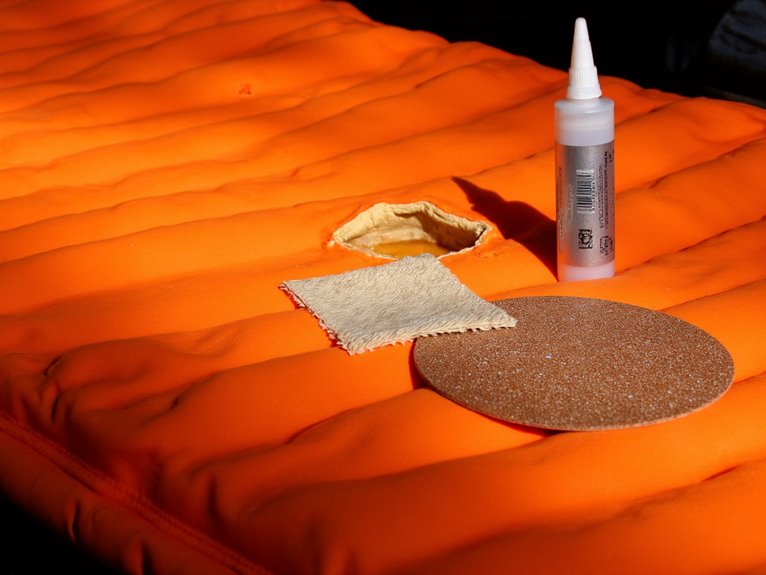The Ultimate Guide on How to Repair and Care for Your Outdoor Gear
Maintaining and repairing your outdoor gear guarantees it lasts longer and functions well. Store gear in a dry, ventilated spot to prevent mold. Regular cleaning with appropriate detergents extends gear life. Avoid direct sunlight and extreme temperatures. Check for damage after each use. Equip a repair kit with adhesive patches, duct tape, and spare parts. Learn basic repair skills for field fixes. At home, use adhesive patches and seam sealer. Keep essentials for quick fixes nearby. Regularly inspect and clean gear. Essential tools like adhesive patches and seam sealer are handy. Spend wisely on durable gear for easier maintenance and sustainability.
We are supported by our audience. When you purchase through links on our site, we may earn an affiliate commission, at no extra cost for you. Learn more. Last update on 2nd January 2026 / Images from Amazon Product Advertising API.
Gear Cleaning and Maintenance
To guarantee the longevity and performance of your outdoor gear, proper cleaning and maintenance practices are essential. Outdoor gear, such as hiking and camping equipment, can be quite an investment, so taking the time to care for it can save you money in the long run. Regarding gear maintenance, storing your equipment in a dry, well-ventilated area is vital. This practice helps prevent the growth of mold and mildew, which can damage fabrics and compromise the integrity of your gear.
Regularly cleaning your gear using appropriate detergents and following the manufacturer’s care instructions can greatly extend the lifespan of your outdoor equipment. Avoiding direct sunlight exposure and extreme temperatures is also critical to preserving the materials of your gear. These simple steps can go a long way in making sure that your equipment remains in top condition for your next outdoor adventure.
Moreover, it’s important to inspect your gear for any signs of wear and tear after each use. By catching minor issues early, you can prevent them from escalating and requiring more extensive repairs. Creating and following a gear maintenance schedule and checklist can help you stay organized and make sure that your outdoor gear is always ready for action. Remember, a little care and attention now can save you from costly repairs or replacements later on.
Field Repairs on the Go
When beginning on outdoor escapades, being equipped with necessary tools and fundamental repair skills for field repairs can be a game-changer in addressing gear issues swiftly and effectively. A well-prepared repair kit is vital for handling unexpected damage during camping and hiking trips. Your repair kit should include adhesive patches, fabric patches, seam sealer, duct tape, and extra tent stakes. These items can help you mend broken gear promptly, allowing you to continue your adventure without major disruptions.
Having basic repair skills is essential for handling common gear issues on the go. Learning how to use these tools effectively can make a significant difference in maintaining your outdoor gear. It’s also wise to pack spare parts and extra repair materials to make sure you are fully prepared for any situation that may arise during your journey. Before starting on your trip, it’s beneficial to inspect your gear thoroughly. Identifying and addressing any existing damage beforehand can prevent potential problems during your outdoor activities.
Home Repair Techniques
Utilizing adhesive patches, fabric patches, and seam sealer are vital home repair techniques for maintaining and prolonging the lifespan of outdoor gear. When your gear gets damaged, these simple fixes can save you money and extend the life of your equipment. For instance, if your tent develops a tear, applying a fabric patch with seam sealer can quickly repair the damage and prevent it from worsening. Duct tape is another essential item for home repairs; its versatility makes it perfect for temporary fixes on tents, backpacks, sleeping bags, shoes, and boots.
Taking the time to learn basic repair skills like patching and replacing damaged parts is important for gear maintenance and repair. By having the necessary tools and materials readily available at home, you can swiftly address any issues that arise. Additionally, regularly checking and cleaning your gear can help you identify damage early on, ensuring that your equipment stays in top condition for your outdoor adventures. Remember, a little maintenance can go a long way in preserving the quality and functionality of your outdoor gear.
Essential Gear Repair Tools
One of the most essential tools for repairing outdoor gear is adhesive patches, which provide quick fixes for a variety of equipment including tents, sleeping bags, and clothing. As a backpacker, it’s vital to have these patches in your repair kit to address any unexpected tears or holes in your camping gear. Learning how to fix these issues promptly can save you from more extensive damage and discomfort during your outdoor adventures. Additionally, fabric patches are handy for repairing tears and holes in items like backpacks, jackets, and tents. Seam sealer is another critical tool to have on hand as it helps fix leaks in tents, rain gear, and other waterproof equipment. Duct tape is a versatile option for temporary repairs on various outdoor gear items, providing a quick solution until a more permanent fix can be made. Packing extra tent stakes is a smart way to prevent any inconvenience caused by damaged or lost stakes while camping. Backpacker magazine recommends having these essential gear repair tools to ensure you can address any issues that arise with your equipment promptly and effectively.
Gear Retirement and Disposal
To guarantee the responsible management of outdoor gear, it is essential to comprehend effective strategies for retiring and disposing of equipment at the end of its useful life. When it comes to gear retirement and disposal, there are several key actions to ponder:
- Resell or Donate: Extend the lifespan of outdoor gear in good condition by reselling it or donating it to others. This not only reduces waste but also gives your gear a chance to be used by someone else who may benefit from it.
- Repurpose Creatively: Instead of discarding old gear, think creatively about repurposing it for alternative uses. For example, old tents can be transformed into waterproof covers or ground tarps, giving them a new lease on life.
- Explore Recycling Options: For gear that cannot be resold or repurposed, investigate recycling options to promote sustainability. Many outdoor gear manufacturers offer recycling programs for products that have reached the end of their usable life.
Investing in durable and repairable gear not only ensures longevity and reliability during use but also facilitates easier repairs and potentially extends the gear’s lifespan. Additionally, understanding outdoor gear sustainability certifications and supporting brands that prioritize responsible disposal practices can further contribute to reducing environmental impact.





